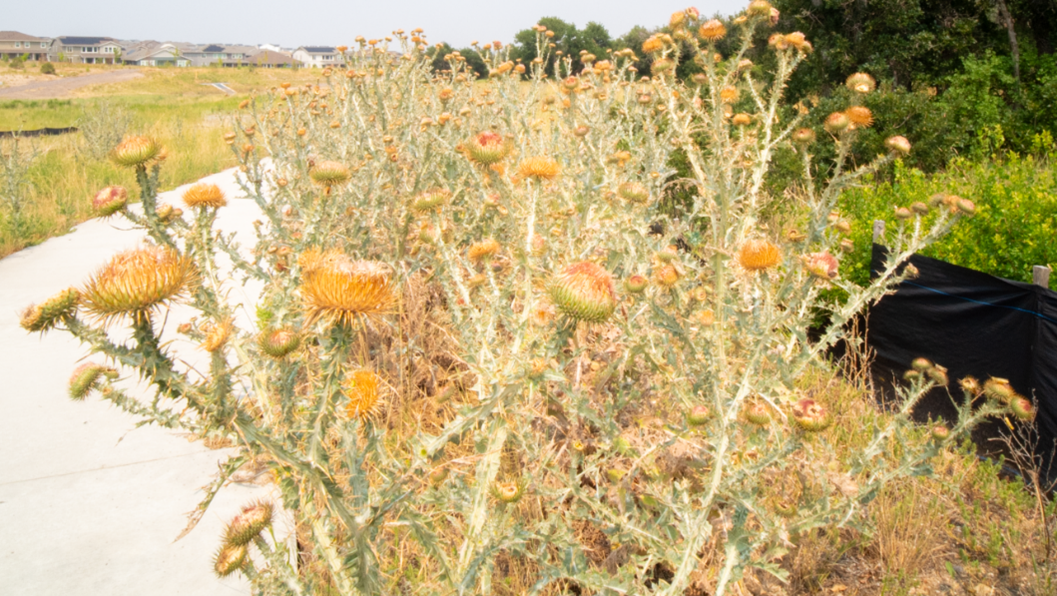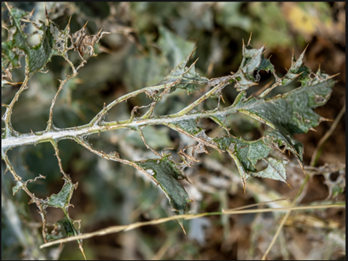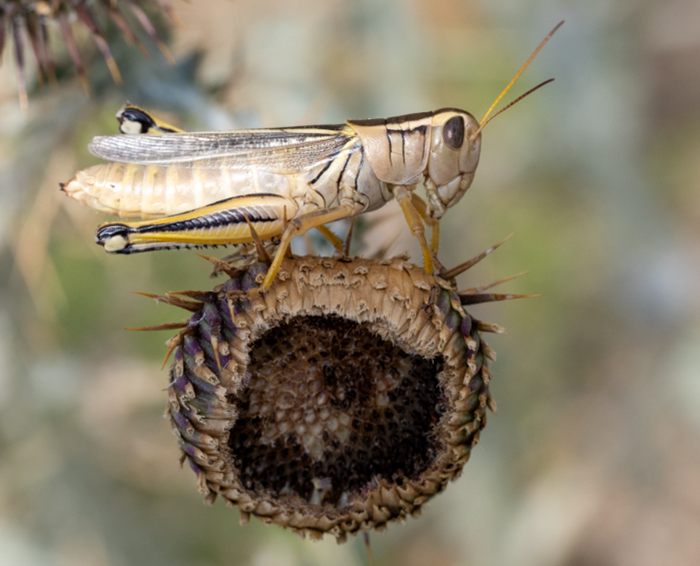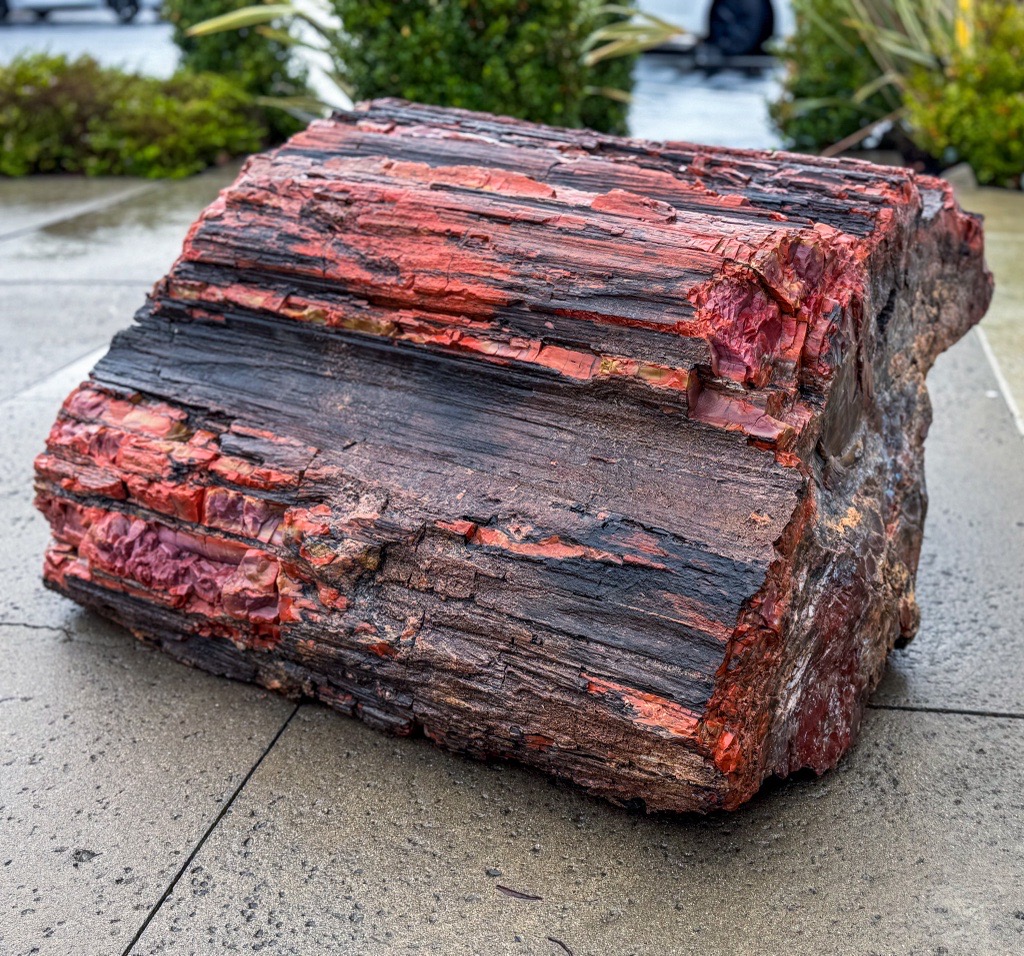Breaking Down Soft Herbaceous Plant Material in Nature
If a tree falls in the forest and nobody is around to hear it, does it make a sound? This question has been debated by philosophers for centuries, as it gets to the core of whether a sensation exists if nobody is around to sense it. At the same time, few question whether the tree itself still exists, regardless of anyone noticing it. However, something must happen to prevent this and other fallen trees from simply piling up on the forest floor forever.
While the softer, herbaceous parts of plants, such as leaves and flowers are easily consumed and provide a major basis for nearly all terrestrial food chains, the woodier stems and leaf veins of these plants are much harder to break down. This can be clearly seen in these Colorado thistles, which extend as far as the eye can see in the high prairie every summer. Grasshoppers will quickly reduce the large leaves of these thorny plants down to mere skeletons as they rapidly eat and multiply throughout the season. The birds and other insectivores consume the grasshoppers, and their droppings, along with occasional carrion, ultimately return nutrients to the soil, nourishing the next year’s field of thistles. This leaves us to wonder what happens to the woodier parts of the plant that were not consumed by insects and other herbivores. If not broken down, this material would eventually pile up and petrify, filling the ecosystem with plant waste.



Petrification: When Microbes Cannot Decay Wood
This begs the question of what happens to the woody material that is left behind, as well as the even woodier material that makes up tree trunks after the tree dies. While everyone who has walked through woodland before is aware that these fallen giants undergo a decay process, few can describe the mechanism by which this happens, or the organisms - both macro and micro - that can participate in this process. More interesting than this typical decay process is what happens if a tree falls at a time or place where these normal mechanisms are unavailable. One set of such places are oxygen-poor environments, such as deep-water sediments; a tree ending up in a deep-water sediment cannot support normal decay processes due to the low oxygen around it and instead will slowly take up minerals from its surroundings in a process known as permineralization. Such a phenomenon can become even more widespread, with a volcanic eruption rapidly blowing over many trees at once and burying their remains in mineral-rich volcanic ash. Over time, flowing water will cause silicification to mineralize these ancient hulks into a petrified forest, as can be seen in Calistoga, California. Two large pieces of petrified wood sit in front of Zymo Research’s main R&D building, a constant reminder to our scientists of the importance of these natural cycles.

The Evolutionary Gap: Coal Formation Before Microbes Could Decay Wood
Fortunately for all life on Earth, petrification is an extremely rare fate for a downed tree. But what if the typical decay process for woody plant material had simply not evolved? Would every terrestrial creature, from the ant to the elephant, be up to their eyeballs in dead wood? It turns out that this exact condition did exist on Earth for a time, a result of the evolutionary lag between the emergence of woody plants and microbial metabolism developing the machinery to break down these hard, intertwined cellulose, hemicellulose, and lignin polymers. The consequence of this lag was, in fact, a massive piling up of fallen trees and other woody plant material. Eventually it would become buried under additional plant material and compressed first into peat, and then ultimately coal. In the modern day, we recognize these ancient, undecayed forests as coal deposits.
Decomposition Processes in the Ocean
A similar question can be asked about what happens in our oceans. Plants fill the critical role of photosynthesizers on land, converting sunlight into biological energy to ultimately support a food chain. However, plants are not found in the ocean; instead, this role belongs to algae, which range from microscopic single-celled organisms to the large, brown, forest-forming kelp. Kelp are not made of cellulose, hemicellulose, and lignin polymers, but rather a more chemically complex mixture of sugars that include sulfated fucoidans. Along with complicating extraction of nucleic acids from kelp samples, these cell wall components provide a different set of chemical challenges to the normal decay process carried out by saprotrophic microbes that is still being understood. Despite the increased complexity of this decay, it still progresses efficiently in nature. This ensures that our beaches, while sometimes littered with piles of seaweed, are not completely covered in it.
Applications of Biomass Decay to Modern Challenges
This process is easy to ignore, as decay of dead and dying biomass is the natural order of things and has been for about as long as there has been life. Still, along with its critical role in “cleaning up” the natural world, harnessing the process of decay holds great potential to solve some of mankind’s greatest challenges. Wood has provided fuel for humans to burn since we discovered fire. While wood was sufficient for fires to keep warm and cook, more sophisticated equipment, being able to efficiently convert wood into a simpler, faster-burning fuel has been a goal of bioenergy research for years. Even more complex would be harnessing the decay of brown algae and its more chemically complex biomass not only for simple fuels, but also to produce useful complex molecules such as nutrients, animal feeds, and precursors for plastic production and other complex chemical synthesis. Finally, being able to efficiently grow and harvest biomass while reliably preventing its decay presents a promising mode for carbon capture.
